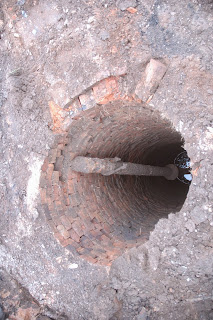We thought we'd give you a brief virtual tour of the site,
starting with the North of Lich St.
One thing to notice about Lich St is how narrow it is, which is
one reason why College St was later built. What remains are the street and the
cellars of the buildings which ran alongside the eastern end. Although Lich St
was laid out in medieval times most of what you see is from much later, as
people rebuilt, refaced and repaired their properties numerous times.
The first building we come to is 1 High St. This property fronted
onto High St, and like High St plots was long and narrow. The front is under
the road, so the cellars are from the rear of the building. Many people
remember this as being a shop called Redifusion.
The cellar hasn't been dug out as much as some, due to the tree
roots which complicated digging. The top of a fireplace can be seen, along with
the pot hook which was left when it was filled, which was a surprise. You can
spot the coal chute on the 1886 Ordnance Survey map, showing how detailed these
maps were.
 |
| Fireplace in No.1 High St |
No.1 Lich St
This was a grocery/provisions store for many years, run by Mr
Mainwaring c1900, and Mr Bell c1915. On the left hand side there is evidence of
a staircase. The cellar seems to have been divided and even lowered, probably
to create more liveable rooms in an already crowded property.
 |
| No.1 Lich St, with remain of staircase shown in the lefthand wall |
Behind Lich St was a yard shared by a number of properties. A well
was discovered (plus an infilled and abandoned well), and on that spot on the
OS map there is a 'P' indicating a water pump.
No.3 Lich St
Originally this was No.2, as the numbering went up one side and
down the other, and in the 1890s changed to alternate numbers. In 1900 it was a
tailors shop. This property didn't have a cellar, for whatever reason, so we
have soil deposits and archaeological features that have survived undisturbed
by later activity. Some of these are producing pottery dating between the 13th
and 17th centuries, so it is likely that this area includes medieval
activity, but do not need to go any deeper during the course of the
redevelopment so this will be left. It does allow us to see a section at the
side to give us an insight into the medieval layers.
 |
| No.3 Lich viewed from in from of No.1 |
 |
| No.3 Lich St |
No.5 Lich St
This was also a provision store, run by Mr Mainwaring and later Mr
Bell, so it must have been frustrating having another building in between. A
staircase can be seen in the corner. It is faced in brick, although these seem
reused so dating the brick won't date the construction. Most of the cellars
seem to have used whatever material was to hand, and usually they wouldn't be
seen by guests so may not use the best material.
 |
| No.5 Lich St |
No.7 Lich St



No comments:
Post a Comment